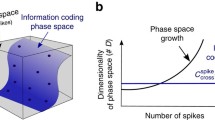Abstract
Firing patterns of neurons are highly variable from trial to trial, even when we record a well-specified neuron exposed to identical stimuli under the same experimental conditions. The trial-to-trial variability of neuronal spike trains may represent some sort of information and provide important indications about neuronal properties. We propose a new method for quantifying the trial-to-trial variability of spike trains, and investigate how the characteristics of noisy neural network models affect the proposed measure.
Similar content being viewed by others
References
Softky WR, Koch C (1993) The highly irregular firing of cortical cells is inconsistent with temporal integration of random EPSPs. J Neurosci 13:334–350
Shadlen MN, Newsome WT (1998) The variable discharge of cortical neurons: implications for connectivity, computation, and information coding. J Neurosci 18:3870–3896
Masuda N, Aihara K (2003) Ergodicity of spike trains: when does trial averaging make sense? Neural Comput 15:1341–1372
Salinas E, Sejnowski TJ (2001) Correlated neuronal activity and the flow of neural information. Nature Rev Neurosci 2:539–551
Benucci A, Verschure PF, König P (2003) Existence of high-order correlations in cortical activity. Phys Rev E 68(4):041905
Tuckwell HC (1988) Introduction to theoretical neurobiology, vol 2. Cambridge University Press, Cambridge
Hunter JD, Milton JG, Thomas PJ, et al (1998) Resonance effect for neural spike time reliability. J Neurophysiol 80:1427–1438
Fujiwara K, Fujiwara H, Tsukada M, et al (2007) Reproducing bursting interspike interval statistics of the gustatory cortex. Biosystems 90:442–448
Gerstner W, Kistler WM (2002) Spiking neuron models. Cambridge University Press, Cambridge
Hansel D, Mato G, Meunier C (1995) Synchrony in excitatory neural networks. Neural Comput 7:307–337
Author information
Authors and Affiliations
Corresponding author
Additional information
This work was presented in part at the 13th International Symposium on Artificial Life and Robotics, Oita, Japan, January 31–February 2, 2008
About this article
Cite this article
Fujiwara, K., Aihara, K. Trial-to-trial variability and its influence on higher-order statistics. Artif Life Robotics 13, 470–473 (2009). https://doi.org/10.1007/s10015-008-0598-1
Received:
Accepted:
Published:
Issue Date:
DOI: https://doi.org/10.1007/s10015-008-0598-1




